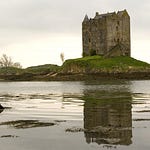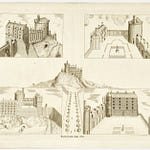Welcome back to A Scottish Castle A Day, brought to you by bagtownclans.com. I’m your host, Colin MacDonald, and today we delve into the turbulent history of Toward Castle, the ancestral seat of Clan Lamont. Nestled on the Cowal Peninsula in Argyll and Bute, this castle has borne witness to moments of grandeur, royal visits, and tragedy. As we explore its story, we uncover not only the history of the Lamonts but also the wider conflicts that shaped the Scottish Highlands.
Toward Castle, or Caisteal an Toll Àird in Gaelic, is a site with deep roots in Scottish history. The Lamonts, originally styled “of Inveryne,” came into possession of the lands surrounding Toward at the southern tip of the Cowal Peninsula through a charter granted in 1472. This charter transformed their holdings into a barony, cementing their influence in the region. However, it was Sir John Lamont, the 10th Chief, who further expanded the clan’s presence by purchasing more land from James V in 1535.
One of the most storied events in Toward Castle’s history took place in 1563 when Sir John hosted none other than Mary, Queen of Scots. In anticipation of her visit, the castle underwent hasty renovations—what had once been a simple keep with thick defensive walls was expanded to include rooms and a great hall. Legend has it that before leaving Toward, Mary planted a tree on the grounds, which stood for centuries until it was felled in 1818. The wood from this tree was crafted into a crown, which was later presented to the 10th Duke of Hamilton and still resides in Dungravel in Lanarkshire.
But Toward Castle was more than just a royal stopover. In 1579, it hosted an allegiance pact between the Lamonts and the mighty Clan MacDonald, overseen by the Lord of the Isles. It must have been a sight to behold: birlinns—traditional Highland longships—beached on the shore while the castle, standing tall with its battlements, filled with the sounds of bagpipes, harps, and revelry. The castle became a cultural and political hub for the Lamonts, a place where bards and poets gathered, and where alliances were made and celebrated with feasting and wine.
However, the fortune of the Lamonts, like many Highland clans, would take a dark turn during the Wars of the Three Kingdoms in the 17th century. Sir John Lamont, the 14th chief, found himself in a precarious position during the conflict between the Royalists and the Covenanters. Though King Charles II had ordered Lamont to lay down his arms, he was besieged by a force of Campbells led by Campbell of Ardkinglas—who was, ironically, the brother of Lady Lamont.
For two weeks, Toward Castle endured a brutal siege. The Lamonts, cut off by land and sea, held out against cannon fire until Sir John agreed to parlay. Under the terms of surrender, the Lamonts were promised safe passage, but the Campbells had other plans. Declaring, “no capitulations should be kept with traitors to God and His covenant,” the Campbells broke their promise, capturing and slaughtering the Lamont men, women, and children. In Dunoon, over 200 Lamont men and boys were executed, marking one of the most brutal massacres in Clan history. Toward Castle was pillaged and burned, leaving it in ruins, and the clan’s chief was taken prisoner. In a moment of courage, Sir John’s sister, Isobel Lamont, hid the signed capitulation document in her hair, smuggling it out of the castle.
The massacre at Toward became one of the charges leveled against Archibald Campbell, the 1st Marquess of Argyll, who was executed in 1661. The Lamonts, who had been one of the most powerful clans in Argyll, never fully recovered from the devastation wrought by the Campbells. After the destruction of Toward Castle, the Lamonts moved their residence to Ardlamont, and the ruined stronghold was sold in 1809 to Kirkman Finlay, a Glasgow merchant and former Lord Provost.
In 1820, Finlay built a new residence, Castle Toward, just 500 meters from the old castle ruins. Designed in the Gothic Revival style by David Hamilton, this country house replaced the medieval stronghold and became the new symbol of Toward. By the 20th century, the castle had undergone significant renovations, including ornate Italian plasterwork and grand landscaping. It was a luxurious estate, far removed from the ancient fortress that once housed the Lamonts.
During World War II, Castle Toward played a unique role as HMS Brontosaurus, a training center for amphibious landings. Soldiers and officers trained on nearby beaches in preparation for D-Day. After the war, the castle became an outdoor education center, providing a different kind of training for school children in Glasgow and beyond.
Though the original Toward Castle stands in ruins, its history is far from forgotten. Now managed by the Clan Lamont Society, it remains a place of pilgrimage for those connected to the clan and for history enthusiasts drawn to its storied past. Castle Toward, the 19th-century mansion, was sold to private owners in 2016, and while its future remains uncertain, its past is indelibly linked to the legacy of the Lamonts.
Today, Toward Castle is more than just a ruin on the Cowal Peninsula—it’s a testament to the resilience of a clan, the intrigue of Scotland’s royal history, and the devastating consequences of clan warfare. For those who visit, the stones of Toward whisper stories of glory, betrayal, and survival.
Thank you for joining us on this episode of A Scottish Castle A Day. I’m Colin MacDonald, and I hope you’ll join us tomorrow as we uncover the fascinating tales behind another of Scotland’s historic castles. Until then, Slán go fóill.










